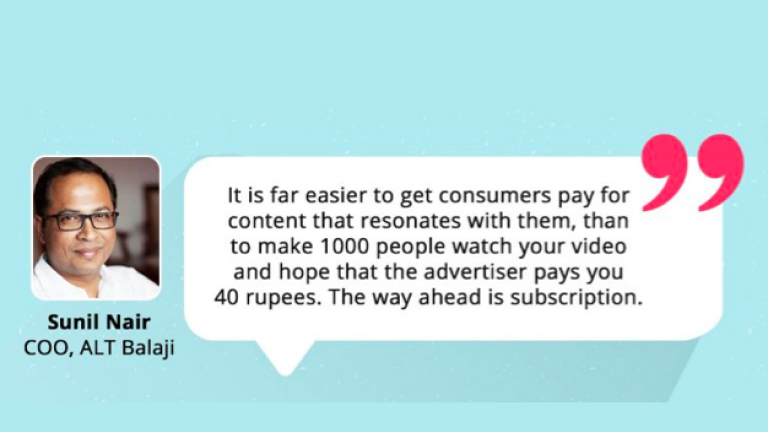The story of Indian Entertainment and Media sector is taking an interesting twist with the OTT boom. With the increased penetration of smartphones and low-cost data packs, Indians are consuming an overwhelming amount of media content through mobile.
According to the recent Internet Trends report, Indians are spending 7x more time on mobile than on TV and 45% of the mobile media time is spent on mobile entertainment. Further, owing to the emergence of streaming services and innovative content offerings by the likes of AIB, TVF, etc. the Indian audience is spoilt for choice.
We spoke to Sunil Nair, COO, ALT Balaji about the OTT disruption and the future of entertainment in India.
Sunil Nair, who first launched his video streaming platform called Nautanki.tv in 2006 (acquired by Hungama in 2010), is a veteran media professional and has worked with Star India and Reliance Jio in the past. He joined ALT Balaji in 2015, India’s first pure play original video content platform owned by Balaji Telefilms Ltd.
With his extensive experience Sunil is working towards making ALT Balaji one of the leading original digital content platforms of India.
In this conversation, Sunil speaks about the factors leading to the OTT boom, the disruption caused by technologies like AR/VR, monetising options and a lot more.
Read on.
Q: What are the factors which will impact the growth of the OTT industry in India and elsewhere?
Sunil Nair: The biggest factor that impacts the growth of OTT in India is the availability of cheap data through telecom players like Jio and Airtel. With so many GBs of free data floating around, there is a lack of content that is relevant to the Indian audiences. There is a lot of play possible with the existing content that originates on traditional broadcast media like Television. However, the real engagement and commitment from audiences willing to pay will be for content that talks to them in their own language.
[bctt tweet=”Commitment from audiences willing to pay will be for content that talks to them in their own language.” username=”Robosoft”]
Q: What are the emerging technologies in the OTT media, that Entertainment and Media companies should watch out for?
Sunil Nair: Virtual Reality is going to be big. It is already making waves in the porn industry, and it’s funny how the porn industry seems to always be at the cutting edge of innovation at all times whether it was for payments in the past or for DRM. AI is already important for recommendations and building inferences for this audience of ONE.
Q: Some tips on building future-ready OTT apps?
Sunil Nair: Big tip is, please do not let awesome technology overwhelm the content. The audiences come to watch content, and if your tech comes in the way, then you have failed. With better tech comes a real problem of forgetting who the audiences are and what they want. In India, the play button is behind a piece of glass, and it must play the video/song when tapped. It is that simple.
[bctt tweet=”Do not let awesome technology overwhelm the content.” username=”Robosoft”]
Q: How can OTT players monetise their offering? Will subscription find favour with consumers or will in-app advertising deliver revenues?
Sunil Nair: I have a favourite line: It is far easier to get the person to pay 100 rupees for content that resonates with him/her than to make 1000 people watch your video and hope that the advertiser pays you 40 rupees. The way ahead is subscription. It is a myth that Indians do not pay for content. And it is a lazy way of operating if ad revenue that was meant for mass audiences is the measure used for this audience that comprises of an individual.
[bctt tweet=”The way ahead is subscription. It is a myth that Indians do not pay for content.” username=”Robosoft”]
Q: With consumers preferring smartphones to consume content, how can ‘Smart TVs’ evolve?
Sunil Nair: My experience is that Indian start sampling content on their smartphones and migrate quickly to larger screens if the content is long form and compelling. Smart TVs, STBs, etc. are all evolving, but sampling will always be on the smartphones. Travel time consumption is on a mobile phone, sit down and lean back watching is on large screens.
Get an in-depth understanding of the global entertainment sector, factors influencing the growth of OTT and future possibilities in the domain. Download our free e-book.






